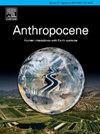养分富集和气候变化对北温带浅水湖泊蓝藻群落历史变化的影响
IF 3.3
2区 地球科学
Q2 ENVIRONMENTAL SCIENCES
引用次数: 0
摘要
湖泊定量生态重建对于提供长期环境记录具有潜在的重要意义,所产生的信息将成为全面了解人类干扰和气候变化对湖泊生态系统影响的宝贵资源。本研究旨在探讨中国北方白洋淀浅温带淡水系统中蓝藻群落历史变化的驱动因素。我们使用多代理方法(如沉积DNA、亚化石硅藻组合)尽可能准确地建立了BLC中蓝藻群落在不同阶段的历史变化。在第一阶段(~ 1902-2012),蓝藻共生网络分析显示,在所有三个采样点,不同属之间的相互作用比第二阶段(~ 2012-2021)更复杂。重建的蓝藻群落与流域沉积硅藻种类组成、地球化学指标和历史记录事件的变化具有良好的相关性。两个水文连通程度较高的采样点(少车店、菜圃台)的蓝藻丰度主要受TP和TN的动态调控,而另一个水文连通程度较弱的采样点(枣寨店)的蓝藻丰度主要受降水的调控。因此,减少营养投入仍然是最谨慎的选择,以避免蓝藻华爆发的风险在BLC。同时,湿地综合体内完整的水文连通性对于通过混合和冲洗减少污染和蓝藻繁殖也至关重要。尽管蓝藻华的命运在最近一段时间内已经大大减少,资源管理者不仅应该采用传统的方法(如营养控制),还应该结合景观尺度的湖沼学监测方法来解决由人类和气候变化耦合干扰引起的长期蓝藻华问题。本文章由计算机程序翻译,如有差异,请以英文原文为准。
Effect of nutrient enrichment and climate change on historical changes of the cyanobacterial community in a shallow north temperate lake in China
Quantitative ecological reconstructions in lakes can be potentially significant for providing long-term environmental records and the information generated would become invaluable source for comprehensive understanding of the effects of human disturbances and climate change on lake ecosystem. Our aim is to explore the drivers of historical changes of the cyanobacterial community in a shallow temperate freshwater system, Baiyangdian Lake Complex (BLC), in northern China. We used a multi-proxy approach (e.g., sedimentary DNA, subfossil diatom assemblages) to establish the historical changes of the cyanobacterial community in BLC over different stages as accurately as possible. At Stage 1 (∼1902–2012), the cyanobacterial co-occurrence network analysis revealed more complex interactions among different genera than at Stage 2 (∼2012–2021) in all three sampling sites. The reconstructed cyanobacterial community correlated well with changes of the sedimentary diatom species composition, geochemical indices and historically documented events in the watershed. The cyanobacterial abundance in two advanced hydrologically-connected sampling sites (Shaochedian, Caiputai) was mainly regulated by the dynamics of TP and TN, while the other relatively weak hydrologically-connected site (Zaozhadian) was regulated by precipitation. Therefore, a reduction in nutrient inputs is still the most prudent option to avoid risk of the outbreak of cyanobacterial blooms in BLC. Meanwhile, intact hydrological connectivity within the wetland complex is also essential to reduce pollution and cyanobacterial blooms through mixing and flushing. Although the fate of cyanobacterial blooms in BLC has been greatly reduced over the recent time, resource managers should not only adopt conventional approaches (e.g., nutrient control) but also incorporate a landscape scale limnological-based monitoring approaches to resolve the long-lasting cyanobacterial bloom problem induced by coupled human and climate change disturbances.
求助全文
通过发布文献求助,成功后即可免费获取论文全文。
去求助
来源期刊

Anthropocene
Earth and Planetary Sciences-Earth and Planetary Sciences (miscellaneous)
CiteScore
6.30
自引率
0.00%
发文量
27
审稿时长
102 days
期刊介绍:
Anthropocene is an interdisciplinary journal that publishes peer-reviewed works addressing the nature, scale, and extent of interactions that people have with Earth processes and systems. The scope of the journal includes the significance of human activities in altering Earth’s landscapes, oceans, the atmosphere, cryosphere, and ecosystems over a range of time and space scales - from global phenomena over geologic eras to single isolated events - including the linkages, couplings, and feedbacks among physical, chemical, and biological components of Earth systems. The journal also addresses how such alterations can have profound effects on, and implications for, human society. As the scale and pace of human interactions with Earth systems have intensified in recent decades, understanding human-induced alterations in the past and present is critical to our ability to anticipate, mitigate, and adapt to changes in the future. The journal aims to provide a venue to focus research findings, discussions, and debates toward advancing predictive understanding of human interactions with Earth systems - one of the grand challenges of our time.
 求助内容:
求助内容: 应助结果提醒方式:
应助结果提醒方式:


